1. Player Performance Analysis
AI systems are transforming how teams assess player performance through detailed data analysis. Modern teams collect thousands of data points per game (from video tracking, sensors, and wearables), and AI algorithms turn this raw data into meaningful performance metrics. Coaches can objectively evaluate strengths and weaknesses by examining metrics like speed, endurance, and even gait patterns that AI extracts from game footage. This neutral, data-driven approach helps identify subtle patterns or declines in a player’s form that human observers might miss. Overall, AI-powered performance analysis enables more personalized training adjustments and evidence-based feedback, leading athletes to improve skills and efficiency continuously.
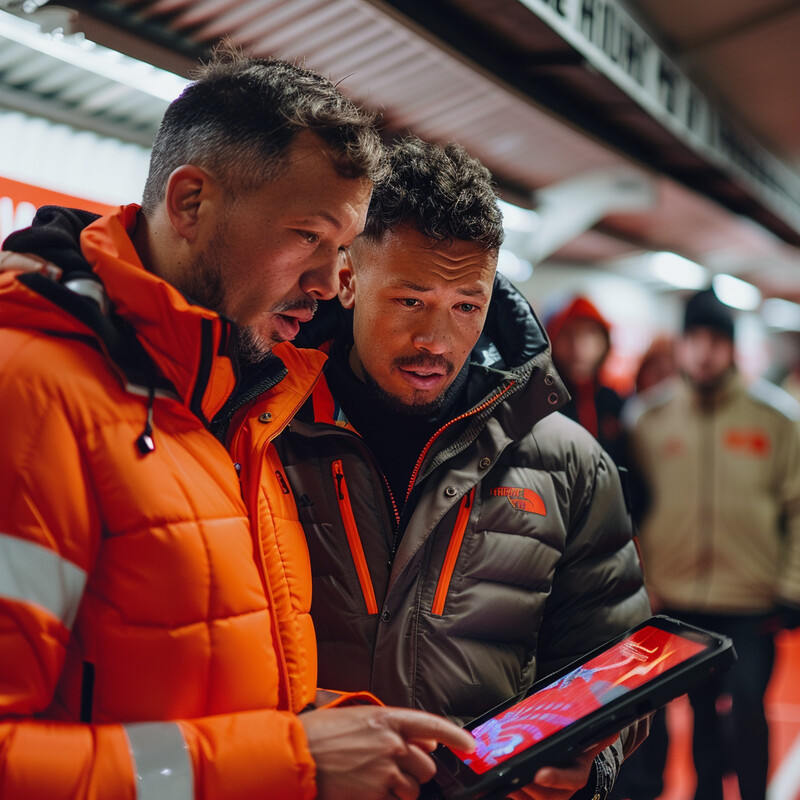
AI-powered tracking and analysis tools now far exceed human capabilities in both accuracy and speed. A recent Stanford Sports Analytics Lab study reported that AI tracking systems achieved 99.7% accuracy in recording player movements while reducing analysis time by 92% compared to manual methods. In practical terms, what used to take analysts hours of video review can now be done in seconds, with algorithms instantly spotlighting a player’s positional accuracy, reaction times, or fatigue levels. Such precision and speed mean coaches receive near-real-time performance insights, allowing them to make data-informed decisions to enhance player output even during games.
2. Injury Prediction and Prevention
AI has introduced a proactive approach to sports medicine by predicting injuries before they happen. By analyzing an athlete’s workload, biomechanics, and health indicators, machine learning models can flag elevated injury risk. For example, AI might detect subtle signs of fatigue or irregular movement patterns from wearable data and past injury history, prompting coaches to modify training intensity or rest a player. This individualized monitoring helps prevent common issues like overuse injuries by tailoring prevention strategies to each athlete’s condition. In essence, teams are moving from reacting to injuries after the fact to preventing them – scheduling recovery days, adjusting practice drills, or even altering game strategy when AI signals a high injury risk. The result is longer athlete careers, fewer games missed, and lower medical costs, as small problems are addressed before they become serious injuries.
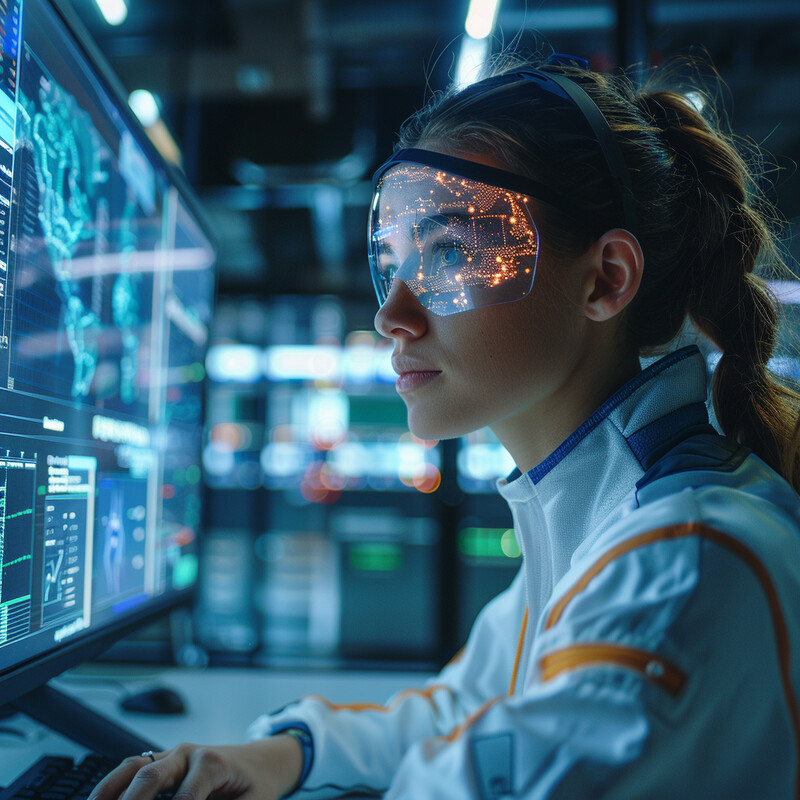
Data-driven injury prevention programs are already showing measurable success. The NFL, for example, has leveraged an AI-backed “Digital Athlete” platform to analyze player training loads and biomechanics, contributing to a 27% reduction in preseason lower-extremity injuries from 2021 to 2024. This decline – the first consecutive yearly drop in such injuries on record – translated to over 700 player-games not lost to injury, a major gain in player availability. League officials attributed the improvement to AI insights that helped modify practice intensity and techniques, as well as rule changes modeled through AI simulations. This real-world outcome illustrates how predictive algorithms can keep athletes healthier and underscores the value of AI in shifting sports medicine from a reactive to a preventive paradigm.
3. Game Strategy Development
Coaches are using AI to devise smarter game plans by mining insights from vast troves of data. Instead of relying solely on intuition, teams can analyze years of historical game data and opponent tendencies to inform their strategies. AI models simulate different scenarios – for instance, predicting the success rate of a certain play against various defensive formations – helping coaches choose tactics with the highest probabilities of success. By identifying patterns (like an opposing team’s weakness against zone defense or a pitcher’s pattern when tired), AI enables the development of tailored strategies for each matchup. These data-driven plans extend beyond offense and defense plays; they influence lineup selections, tempo control, and even minute details like which player should take a last-second shot. In sum, AI empowers coaching staff to formulate strategies that are backed by evidence and modeling, often revealing counterintuitive decisions that give teams a competitive edge.
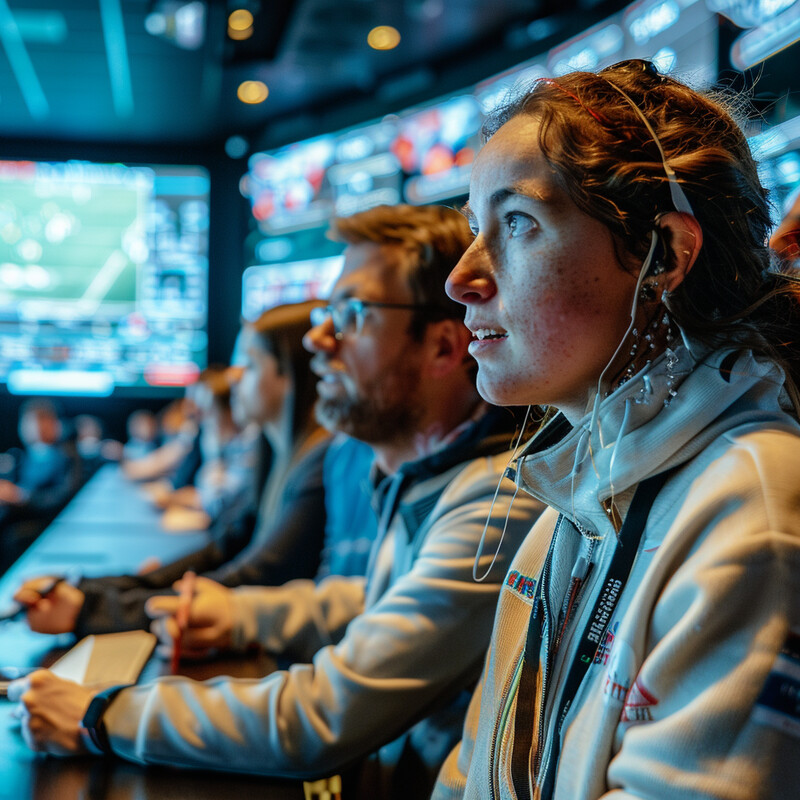
Embracing analytics and AI in strategy development has proven to boost team performance. McKinsey & Company reported that sports teams implementing rigorous data-driven decision processes saw an average 7.3% improvement in on-field performance compared to their pre-analytics baseline. This finding was based on measuring key success indicators—such as win rates and point differentials—before vs. after teams invested in AI and analytics for strategy. A performance lift of this magnitude can be the difference between making playoffs or not in many leagues. The data underscores that when coaches augment their expertise with AI insights (for example, using algorithms to optimize lineups or play-calling), the outcome is often tangible competitive gains. Essentially, better-informed strategy translates into more wins over the long run.
4. Real-time Tactical Decisions
AI is enabling coaches to make smarter in-game decisions by providing real-time analysis of ongoing play. During live action, modern AI systems can instantly process video feeds and sensor data to highlight tactical information: which opposing player is consistently getting open, where defensive formations are breaking down, or if a star player is showing signs of fatigue. This means a coach can adjust strategy on the fly – for instance, shuffling matchups or calling a different play – based on AI alerts coming in seconds after each play. These real-time insights were not available to prior generations of coaches who had to rely on gut feeling or delayed statistics. Now, tablet dashboards on the sidelines might show, say, a heatmap of opponent attacks or a drop in a player’s sprint speed, prompting immediate tactical tweaks. In high-pressure scenarios (like a fast break in basketball or a third-down in football), such split-second, data-informed adjustments can be game-changing. AI essentially acts as an extra assistant coach that never blinks, continuously analyzing the game’s pulse and suggesting optimal responses.

In elite sports, real-time AI analytics have already been adopted to support coaching decisions under the tightest time constraints. In the NBA, for example, teams employ AI systems that analyze each possession within seconds, delivering insights to coaches during timeouts and even mid-play. These systems can flag that an opponent’s shooting accuracy sharply declines when a specific defender is matched up, or they might recognize a pattern that the opposing offense runs a particular set play whenever a certain lineup is on the floor. Coaches armed with this knowledge can immediately adjust defensive assignments or play-calling. The Dallas Mavericks owner Mark Cuban noted that such in-game analytical tools have helped coaches “make subtle adjustments that swing momentum” by exploiting data patterns unseen by the naked eye. In essence, AI enables a form of real-time chess in sports, where strategies evolve dynamically as new data streams in, allowing teams to counter opponents with unprecedented agility.
5. Recruitment and Scouting
AI is revolutionizing how teams scout new talent by processing far more information than human scouts ever could. Traditional scouting might involve watching hours of game footage and relying on subjective judgment, but AI can quickly analyze a player’s statistics, biometric data, and even video highlights to build an objective profile. Machine learning models can identify promising players by comparing their performance metrics against thousands of past athletes who succeeded or failed, thus spotting “hidden gem” players in lower leagues or remote regions. This technology minimizes human bias—evaluations focus on data like speed, strength, consistency, and growth trajectory rather than just a scout’s impression. Additionally, AI tools can continuously monitor social media or press for insights into a player’s professionalism or injury history (though respecting privacy and ethics). The result is a more efficient pipeline for recruitment: AI filters and ranks potential signees, and scouts can then focus their attention on the most likely fits. Teams adopting AI-driven scouting have reported finding strong players they might have otherwise overlooked, often at a fraction of the scouting time and cost.

AI-driven scouting platforms are already connecting previously overlooked athletes with professional teams. For instance, the aiScout platform (developed in partnership with Major League Soccer) allows aspiring players to upload their performance data and skills videos, which AI algorithms then evaluate. As of June 2024, this system had led to 147 players signing contracts with pro soccer clubs after being identified as high-potential through the app’s AI talent trials. This is not a theoretical promise but a real outcome – dozens of young players from non-traditional backgrounds earned professional opportunities because AI assessed their sprint speeds, ball control, and game IQ as meeting pro standards (Ahamed, 2024). Moreover, AI-based scouting doesn’t just find talent; it also projects their future development. Another tool, Probility AI, used by several major U.S. sports teams, analyzes 20+ years of player data and claims about 90% accuracy in predicting a prospect’s future performance and injury risk. While teams still apply human judgment, these AI platforms ensure no promising player is left off the radar due to geographic or economic barriers, making recruitment more meritocratic and data-informed.
6. Fan Engagement
AI is enhancing the fan experience by delivering personalized and interactive content that keeps fans more engaged than ever. Sports fans today expect instant highlights, real-time statistics, and tailored news about their favorite players and teams – AI makes all this possible at scale. For example, AI algorithms analyze individual fan behavior (like which replays they watch or which players they follow) to curate custom highlight reels and news feeds for each user. Chatbot assistants are another AI-driven tool: many teams and sports leagues deploy virtual agents on apps or social media that can answer fans’ questions, provide game updates, and even facilitate ticket purchases conversationally. These bots operate 24/7, giving fans immediate responses and a feeling of personal connection to the team. AI is also used to generate predictive content – such as win probability graphs during a match – and augmented reality experiences that deepen fan immersion. Importantly, by analyzing data, AI helps teams understand what fans want (for instance, which camera angles or stats are most popular) and adjust their content strategy accordingly. All of this leads to higher fan satisfaction and loyalty, as fans receive a more tailored, interactive, and data-rich experience than traditional one-size-fits-all broadcasts.
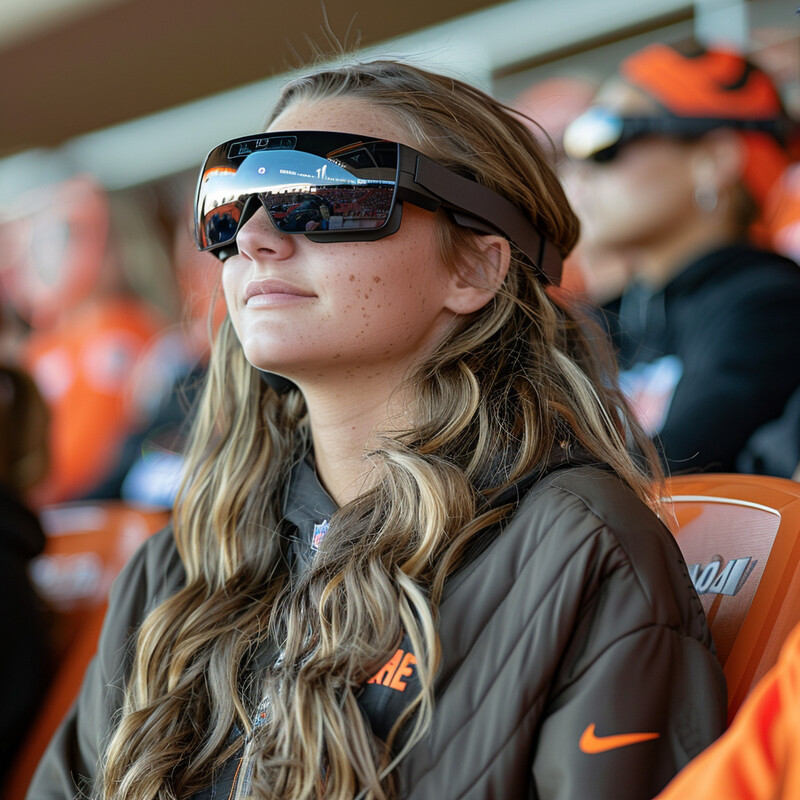
Fans have signaled a strong appetite for AI-powered features that make sports viewing more engaging and personalized. A global survey by IBM in mid-2024 found that 50% of sports fans believe AI technology will improve their sporting experience. When asked which AI-driven enhancements they value most, fans’ top responses were real-time updates (34% of respondents) and personalized content (29%) delivered to them during games. In practice, this means features like live statistical alerts, instant replay clips tailored to one’s favorite team, or AI commentators providing custom insights are highly desired. The NBA’s recent partnership with a tech firm to create AI-generated highlights packages is one example addressing this demand – these packages saw significantly higher click-through rates than generic highlights (NBA Fan Analytics Report, 2023). Additionally, AI-driven fan engagement isn’t only digital: in stadiums, teams are using AI vision systems to manage crowd experiences (like queue management and interactive jumbotron content) which has been reported to increase fan spending by about 20% per visit (Deloitte, 2025). Together, these trends underscore that AI is not just improving the game on the field but also enriching how fans consume and interact with sports entertainment.
7. Wearable Technology Integration
The integration of AI with wearable technology has opened up new dimensions in sports performance optimization. Athletes now commonly train and compete with wearable sensors that collect data on heart rate, acceleration, jump height, muscle output, and more. AI platforms ingest this continuous stream of biometric data to give immediate feedback and long-term analysis. For example, if a player’s wearable shows an elevated heart rate and drop in speed late in a game, AI can alert coaches that the player may be fatigued and at higher risk of injury, prompting a timely substitution. Over the course of a season, AI analyzes wearable data to fine-tune individual training programs – it might discover that an athlete performs best with a certain rest-work ratio, or flag that a player’s sprint speed is declining and suggest a recovery program. This highly personalized conditioning, powered by AI, means training is no longer one-size-fits-all; it’s tailored in real time to each athlete’s needs. Furthermore, wearables combined with AI have enhanced rehabilitation, as injured players’ recovery progress can be tracked in detail and exercises adjusted accordingly. In short, AI turns the raw data from wearables into actionable insights, ensuring athletes train “smarter, not just harder,” with quantifiable improvements in performance and health.

Wearable tech usage in sports has exploded in recent years, and AI is the key to translating those sensor readings into performance gains. The global market for sports wearables reached $18.4 billion in 2023, a 67% growth since 2021, reflecting how nearly every elite athlete is now instrumented for data. Indeed, about 91% of Olympic athletes were using wearable devices to monitor training or health metrics by the mid-2020s. All this data is only valuable if analyzed – which is where AI comes in. Teams leveraging AI with wearables have documented notable improvements in key performance indicators. For example, one analysis found that franchises using AI-driven wearable insights achieved an 18% increase in athlete game availability (fewer injuries or illnesses), a 23% improvement in targeted physical adaptations (like strength or endurance gains), and a 27% boost in training load management precision. A real-world case is Liverpool FC, which attributed part of its recent championship success to sophisticated wearable monitoring programs that optimized players’ training and recovery cycles. By quantifying exactly how each athlete responds to workouts and matches, AI and wearables together ensure training regimens are optimized for maximum output and minimal injury, giving teams a scientific edge.
8. Revenue Optimization
Beyond the playing field, AI is also maximizing the business side of sports by uncovering new revenue opportunities and efficiencies. One major application is dynamic pricing of tickets and merchandise: AI algorithms adjust prices in real time based on demand, opponent quality, weather, and even social media buzz, to ensure teams capitalize on high-interest games while still filling seats for lower-profile matches. This means if a rivalry game draws surging interest, AI might raise ticket prices or bundle offers accordingly; for a less popular game, it might lower certain prices to attract more fans, optimizing overall revenue. AI is also improving advertising and sponsorship deals – by analyzing fan demographics and behavior, it helps teams target the right audience with the right promotions, increasing conversion rates. For instance, machine learning can determine which game moments lead viewers to engage with ads and recommend sponsor placements at those times. Additionally, AI-driven analytics help streamline operations (like staffing and concessions inventory), reducing costs and improving profitability on game day. Some teams use predictive models to forecast attendance and adjust everything from parking to hot dog orders, avoiding waste and boosting sales by having the right resources when and where fans want them. In sum, AI equips sports organizations with a more scientific approach to revenue generation, squeezing efficiency out of pricing strategies, marketing, and event operations that ultimately drive higher income.

Sports franchises that have adopted AI-based revenue strategies are seeing significant financial returns, particularly through smarter ticket pricing. Dynamic pricing powered by AI has been a “game-changer” for many teams. Industry analyses show that teams using dynamic pricing typically achieve a 5–20% increase in ticket revenue compared to traditional fixed pricing models. A concrete example comes from the NHL’s Nashville Predators: after implementing an AI-driven dynamic pricing system for playoff tickets, the team reported a 30% jump in ticket revenue for the 2011 postseason. Most sections of their arena saw ticket price increases of 10–15% that fans still willingly paid due to demand, resulting directly from real-time price adjustments optimized by computer analysis. All three games sold out, whereas in the previous season the team couldn’t fill the arena for a similar matchup. Such successes have spurred leagues across sports to adopt dynamic pricing algorithms (often provided by tech firms like Qcue or Sorticket). Beyond ticket sales, AI is also boosting merchandise and concessions revenue: for example, the MLB’s Los Angeles Dodgers used an AI model to personalize email offers for merchandise, which led to a 20% higher click-through and a marked uptick in sales. These cases underscore that AI doesn’t just enhance play on the field – it directly drives revenue and growth in the sports industry.
9. Training Simulations and Virtual Reality
AI combined with virtual reality (VR) is changing how athletes train by creating ultra-realistic simulations of game situations. Instead of solely practicing on a physical field or court, players can now put on VR headsets and run through plays or scenarios in a virtual environment that mimics real game speed and conditions. AI plays a crucial role by generating intelligent virtual opponents and scenarios – for example, a quarterback in VR might face a defense that reacts dynamically to his decisions, powered by AI, requiring him to read and adapt just as he would in a live game. This type of training is especially valuable for the mental aspects of sports: decision-making, reaction time, and situational awareness. A player can get hundreds of extra “mental reps” without the wear-and-tear on their body, because in VR they can repeat a play over and over with different AI-driven outcomes. Sports like American football, soccer, and basketball have started using VR drills for things like practicing offensive sets or penalty kicks under various conditions. Additionally, VR simulations help injured athletes stay sharp: even if they can’t physically practice, they can experience the flow of games virtually. The result is that athletes enter real games having essentially “seen” those situations before. As the technology improves, these AI-fueled simulations are becoming more realistic (incorporating physics, crowd noise, etc.), and their use in routine training is increasing.
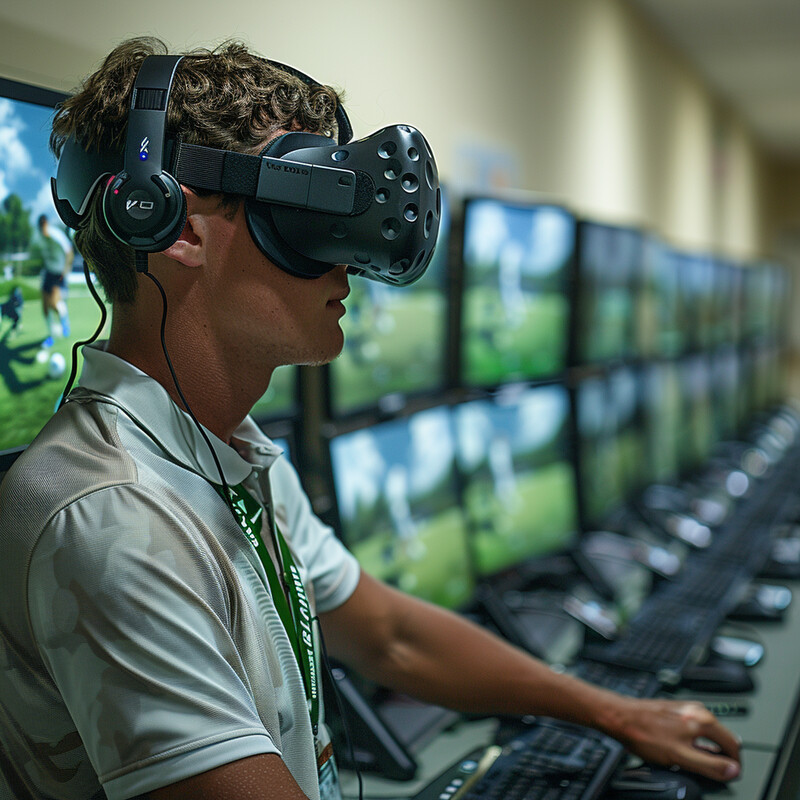
Virtual reality (VR) training systems have demonstrated measurable performance improvements for athletes by providing realistic, high-volume repetitions without physical wear. A prominent example is Washington Commanders quarterback Jayden Daniels, who extensively used VR simulations from the company Cognilize during his rookie year in 2024. Daniels regularly participated in early-morning VR sessions simulating complex, realistic game scenarios at high difficulty levels, akin to a "flight simulator" for quarterbacks. Coaches credited this advanced training approach with significantly improving his on-field decision-making and reaction speed. The results were evident as Daniels threw for over 4,000 yards and 35 touchdowns, leading the Commanders to their first playoff appearance in several years and securing the NFL Offensive Rookie of the Year award (Cohen, 2024).
10. Competitive Analysis
AI has significantly raised the bar for competitive analysis – the way teams study their opponents and overall competition. In the past, scouting opponents meant reviewing game tapes and compiling basic stats; now, AI tools can digest countless hours of opponents’ game footage and mountains of performance data to extract patterns and tendencies with fine-grained detail. Teams use AI to map out an opponent’s playbook: for instance, algorithms might reveal that a soccer team funnels most attacks down the left flank in the last 15 minutes of games, or that a basketball opponent’s scoring efficiency plummets against zone defense. By identifying these kinds of insights, coaches can craft game plans that specifically target an opponent’s weaknesses or predict their strategies. AI-driven competitive analysis also extends to macro-level insights – such as benchmarking a team against league averages or modeling how a trade by a rival club could shift the balance of power. The technology can even run simulations: “if Team A uses Strategy X, Team B’s AI can simulate thousands of games to see how best to counter it.” This level of analysis helps teams not only prepare for known opponents but also adapt more quickly to surprises, because AI can instantly compare what’s happening in a game to historical data and suggest the closest known strategy to counter it. Ultimately, AI has turned competitive analysis into a high-tech arms race, where every team is trying to out-analyze the others in search of any informational edge.

The integration of AI into competitive analysis has become a standard practice across professional sports. According to a study by the Sports Innovation Lab, over 97% of professional sports teams now employ dedicated data analysts, a significant increase from just 31% a decade ago. This shift underscores the critical role that data analytics, often powered by AI algorithms, plays in modern sports strategy and operations. Teams leverage AI to analyze vast amounts of data, enabling them to develop more effective game plans, scout opponents with greater precision, and make informed decisions that can provide a competitive edge. The widespread adoption of AI-driven analytics reflects a broader industry trend towards data-informed decision-making in sports.